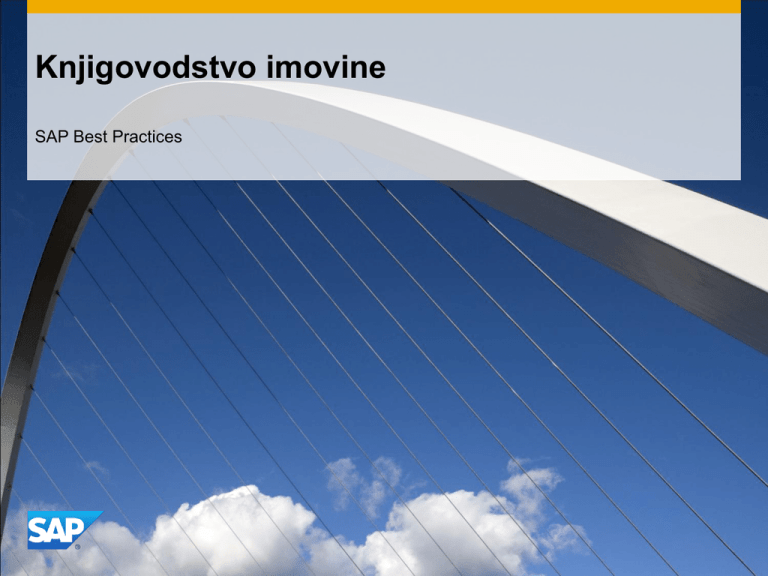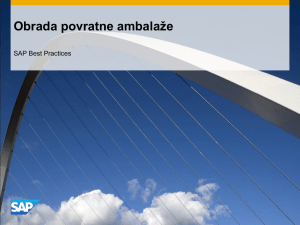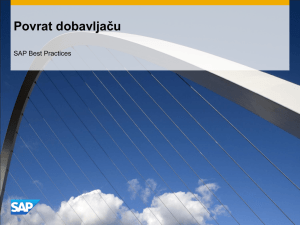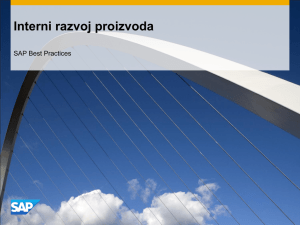
Knjigovodstvo imovine
SAP Best Practices
Svrha, prednosti i ključni koraci procesa
Svrha
Komponenta knjigovodstva imovine (FI-AA) koristi se za upravljanje i nadzor dugotrajne imovine sa SAP
sustavom. U financijskom računovodstvu služi kao pomoćna knjiga glavnoj knjizi i pruža detaljne
informacije o transakcijama koje uključuju dugotrajnu imovinu.
Prednosti
Cijeli životni vijek imovine od narudžbenice ili početne nabave (mogućnost upravljanja imovinom kao
imovinom u pripremi) pa sve do povlačenja iz upotrebe.
Izračun vrijednosti amortizacije i kamata
Predviđanje amortizacije
Ključni koraci procesa
Nabava od dobavljača
Nabava s automatskim protuknjiženjem
Povlačenje s prihodom
Prodaja imovine bez kupca
Naknadno aktiviranje
Pripisi
Imovina u pripremi
Izvođenje knjiženja amortizacije
Knjiženje vrijednosti troškova nabave i proizvodnje
Simulacija amortizacije / planiranje primarnih troškova
© 2011. SAP AG. Sva prava pridržana.
2
Potrebne SAP aplikacije i uloge u poduzeću
Potrebno
Paket proširenja 5 za SAP ERP 6.0
Uloge u poduzeću
Računovođa Osnovnih Sredstava
Računovođa Saldakonti dobavljača
Računovođa glavne knjige
© 2011. SAP AG. Sva prava pridržana.
3
Detaljni opis procesa
Nabava od dobavljača
Nabava vanjske imovine poslovna je transakcija koja rezultira nabavom imovine od
poslovnog partnera. Nabava se može knjižiti integrirana sa ili bez saldakonta dobavljača.
Nabava s automatskim protuknjiženjem
Imovina se može automatski knjižiti na obračunski konto nabave dugotrajne imovine.
Povlačenje s prihodom
Imovina je prodana što rezultira prihodom. Prodaja se knjiži kod kupca.
Imovina je prodana što rezultira prihodom. Prodaja se knjiži na obračunski konto.
Imovinu treba otpisati bez prihoda.
Prodaja imovine bez kupca
Prodaja imovine s djelomičnim povlačenjem i bez kupca
© 2011. SAP AG. Sva prava pridržana.
4
Detaljni opis procesa
Naknadno aktiviranje
Naknadno aktiviranje predstavlja naknadne ispravke troškova nabave i proizvodnje (TNP)
dugotrajne imovine.
Pripisi
Pripisom se općenito podrazumijeva naknadna promjena vrednovanja imovine.
Imovina u pripremi
Imovina u pripremi (IuP) poseban je oblik materijalne imovine.
Proces IuP uključuje predujam, završnu fakturu i završni obračun.
© 2011. SAP AG. Sva prava pridržana.
5
Detaljni opis procesa
Izvođenje knjiženja amor.
Knjiženje amortizacije trebalo bi izvoditi periodično zato što se konta amortizacije ne
ažuriraju odmah.
Sustav kreira dokumente knjiženja za svako područje vrednovanja i grupu konta u skladu s
ciklusima knjiženja navedenima u prilagodbi.
Knjiženje vrijednosti troškova nabave i proizvodnje
Pored knjiženja amortizacije (pomoću izvođenja knjiženja amortizacije) najvažnija
periodična obrada koju izvodite je knjiženje promjena vrijednosti bilance imovine. Te se
promjene sastoje od svih knjiženja koja utječu na TNP imovine, uključujući nabave,
povlačenja i tako dalje.
Simulacija amortizacije / planiranje primarnih troškova
Također možete knjižiti planiranu amortizaciju kao planirane troškove na mjesta troška ili
interne naloge kojima je pojedinačna dugotrajna imovina dodijeljena.
© 2011. SAP AG. Sva prava pridržana.
6
Dijagram toka procesa
Događaj
Knjigovodstvo imovine - pregled
Trebaju se
kreirati
matični
podaci
imovine
Računovođa Osnovnih Sredstava
Nabava imovine
Povlačenja
Prijenos unutar tvrtke
Asset Explorer
Naknadno aktiviranje
Periodička obrada
Pripis
Prijenos rezervi
Naplanirana amortizacija
Imovina u pripremi
Informacijski sustav
© 2011. SAP AG. Sva prava pridržana.
7
Dijagram toka procesa
Računovođa Osnovnih Sredstava
Događaj
Knjigovodstvo imovine – nabava imovine
162
pregled
Nabava imovine
Nabava
sa
saldakon
tima
dobavlja
ča
Ne
Nabava s
automatskim
protuknjiženjem
Da
Nabava integrirana
s račun. saldakonta
dobavljača
© 2011. SAP AG. Sva prava pridržana.
8
Dijagram toka procesa
Računovođa Osnovnih Sredstava
Događaj
Knjigovodstvo imovine – povlačenja
162
pregled
Imovina za
povlačenje
Povlačen
je s
očekivani
m
prihodo
m
Ne
Povl. imov. iz
upotr. zbog otpisa
Da
© 2011. SAP AG. Sva prava pridržana.
Povlačenje
s kupcem
Ne
Povlačenje s
prihodom bez
kupca
Da
Povlačenje s
prihodom i kupcem
9
Dijagram toka procesa
Računovođa Saldakonti
dobavljača
Računovođa Osnovnih
Sredstava
Događaj
Knjigovodstvo imovine – imovina u pripremi
Imovinu treba izgraditi
bez investicijskog
naloga
Kreiranje
IuP /
imovine za
završni
obračun
(155.02)
Knjiženje zahtjeva
za predujam
© 2011. SAP AG. Sva prava pridržana.
162
pregled
Odobren
predujam
Knjiž. zavr. fakture
Knjiži predujam
Održavanje pravila
obračuna
Obračun predujma
10
Dijagram toka procesa
Zatv. na
kraju
razdoblja
162
pregled
IuP
obračun
(164)
IuP obračun
Izvođenje
amortizacije
Pon. izračun
vrijed.
Izvođenje
knjiženja amor.
Računovođa Osnovnih
Sredstava
Računovo
đa glavne
knjige
Računovođa Osnovnih
Sredstava
Događaj
Knjigovodstvo imovine – periodička obrada
© 2011. SAP AG. Sva prava pridržana.
Knjiženje
vrijednosti TNP
Lista pojed.
knjiženja za
imovinu
Otvaranje i
zatvaranje
imovine fin.
razd.
Simulacija
amortizacije i
planiranje
primarnih
troškova
Kraj
godine
Ne
Usklađenje
konta
Zatv. na kraju
god. za dugot.
imov.
Da
Prom. fisk.
godine za
imovinu
11
Legend
<Function>
Symbol
Description
Usage Comments
Band: Identifies a user role, such as Accounts
Payable Clerk or Sales Representative. This band
can also identify an organization unit or group,
rather than a specific role.
Role band contains
tasks common to that
role.
Symbol
Diagram
Connection
The other process flow symbols in this table go
into these rows. You have as many rows as
required to cover all of the roles in the scenario.
External
to SAP
External Events: Contains events that start or end
the scenario, or influence the course of events in
the scenario.
Business
Activity / Event
SubProcess
Reference
Process
Decision
Flow line (solid): Line indicates the normal sequence
of steps and direction of flow in the scenario.
Flow line (dashed): Line indicates flow to
infrequently-used or conditional tasks in a
scenario. Line can also lead to documents involved
in the process flow.
Connects two tasks in
a scenario process or
a non-step event
Business Activity / Event: Identifies an action that
either leads into or out of the scenario, or an
outside Process that happens during the scenario
Does not correspond
to a task step in the
document
Unit Process: Identifies a task that is covered in a
step-by-step manner in the scenario
Corresponds to a task
step in the document
To next / From last Diagram: Leads
to the next / previous page of the
Diagram
Flow chart continues on the next /
previous page
Hardcopy / Document: Identifies a
printed document, report, or form
Does not correspond to a task
step in a document; instead, it is
used to reflect a document
generated by a task step; this
shape does not have any outgoing
flow lines
Financial Actuals: Indicates a
financial posting document
Does not correspond to a task
step in a document; instead, it is
used to reflect a document
generated by a task step; this
shape does not have any outgoing
flow lines
Budget Planning: Indicates a
budget planning document
Does not correspond to a task
step in a document; instead, it is
used to reflect a document
generated by a task step; this
shape does not have any outgoing
flow lines
Manual Process: Covers a task
that is manually done
Does not generally correspond to
a task step in a document;
instead, it is used to reflect a task
that is manually performed, such
as unloading a truck in the
warehouse, which affects the
process flow.
Existing Version / Data: This block
covers data that feeds in from an
external process
Does not generally correspond to
a task step in a document;
instead, this shape reflects data
coming from an external source;
this step does not have any
incoming flow lines
System Pass / Fail Decision: This
block covers an automatic
decision made by the software
Does not generally correspond to
a task step in the document;
instead it is used to reflect an
automatic decision by the system
that is made after a step has been
executed.
Financial
Actuals
Process Reference: If the scenario references
another scenario in total, put the scenario number
and name here.
Corresponds to a task
step in the document
Sub-Process Reference: If the scenario references
another scenario in part, put the scenario number,
name, and the step numbers from that scenario
here
Corresponds to a task
step in the document
Process Decision: Identifies a decision / branching
point, signifying a choice to be made by the end
user. Lines represent different choices emerging
from different parts of the diamond.
Does not usually
correspond to a task
step in the document;
Reflects a choice to
be made after step
execution
© 2011. SAP AG. Sva prava pridržana.
Usage Comments
Hardcopy /
Document
Budget
Planning
Unit Process
Process
Reference
Description
Manual
Process
Existing
Version /
Data
System
Pass/Fail
Decision
12
© 2011 SAP AG. All rights reserved
No part of this publication may be reproduced or transmitted in any form or for any purpose
without the express permission of SAP AG. The information contained herein may be
changed without prior notice.
Some software products marketed by SAP AG and its distributors contain proprietary
software components of other software vendors.
Microsoft, Windows, Excel, Outlook, and PowerPoint are registered trademarks of Microsoft
Corporation.
IBM, DB2, DB2 Universal Database, System i, System i5, System p, System p5, System x,
System z, System z10, System z9, z10, z9, iSeries, pSeries, xSeries, zSeries, eServer,
z/VM, z/OS, i5/OS, S/390, OS/390, OS/400, AS/400, S/390 Parallel Enterprise Server,
PowerVM, Power Architecture, POWER6+, POWER6, POWER5+, POWER5, POWER,
OpenPower, PowerPC, BatchPipes, BladeCenter, System Storage, GPFS, HACMP,
RETAIN, DB2 Connect, RACF, Redbooks, OS/2, Parallel Sysplex, MVS/ESA, AIX,
Intelligent Miner, WebSphere, Netfinity, Tivoli and Informix are trademarks or registered
trademarks of IBM Corporation.
Linux is the registered trademark of Linus Torvalds in the U.S. and other countries.
Adobe, the Adobe logo, Acrobat, PostScript, and Reader are either trademarks or
registered trademarks of Adobe Systems Incorporated in the United States and/or other
countries.
Oracle is a registered trademark of Oracle Corporation.
UNIX, X/Open, OSF/1, and Motif are registered trademarks of the Open Group.
Citrix, ICA, Program Neighborhood, MetaFrame, WinFrame, VideoFrame, and MultiWin are
trademarks or registered trademarks of Citrix Systems, Inc.
HTML, XML, XHTML and W3C are trademarks or registered trademarks of W3C®, World
Wide Web Consortium, Massachusetts Institute of Technology.
Java is a registered trademark of Sun Microsystems, Inc.
JavaScript is a registered trademark of Sun Microsystems, Inc., used under license for
technology invented and implemented by Netscape.
Business Objects and the Business Objects logo, BusinessObjects, Crystal Reports, Crystal
Decisions, Web Intelligence, Xcelsius, and other Business Objects products and services
mentioned herein as well as their respective logos are trademarks or registered trademarks
of Business Objects Software Ltd. Business Objects is an SAP company.
Sybase and Adaptive Server, iAnywhere, Sybase 365, SQL Anywhere, and other Sybase
products and services mentioned herein as well as their respective logos are trademarks or
registered trademarks of Sybase, Inc. Sybase is an SAP company.
All other product and service names mentioned are the trademarks of their respective
companies. Data contained in this document serves informational purposes only. National
product specifications may vary.
The information in this document is proprietary to SAP. No part of this document may be
reproduced, copied, or transmitted in any form or for any purpose without the express prior
written permission of SAP AG.
This document is a preliminary version and not subject to your license agreement or any
other agreement with SAP. This document contains only intended strategies, developments,
and functionalities of the SAP® product and is not intended to be binding upon SAP to any
particular course of business, product strategy, and/or development. Please note that this
document is subject to change and may be changed by SAP at any time without notice.
SAP assumes no responsibility for errors or omissions in this document. SAP does not
warrant the accuracy or completeness of the information, text, graphics, links, or other items
contained within this material. This document is provided without a warranty of any kind,
either express or implied, including but not limited to the implied warranties of
merchantability, fitness for a particular purpose, or non-infringement.
SAP shall have no liability for damages of any kind including without limitation direct,
special, indirect, or consequential damages that may result from the use of these materials.
This limitation shall not apply in cases of intent or gross negligence.
The statutory liability for personal injury and defective products is not affected. SAP has no
control over the information that you may access through the use of hot links contained in
these materials and does not endorse your use of third-party Web pages nor provide any
warranty whatsoever relating to third-party Web pages.
SAP, R/3, SAP NetWeaver, Duet, PartnerEdge, ByDesign, SAP BusinessObjects Explorer,
StreamWork, and other SAP products and services mentioned herein as well as their
respective logos are trademarks or registered trademarks of SAP AG in Germany and other
countries.
© 2011 SAP AG. All rights reserved.
13



